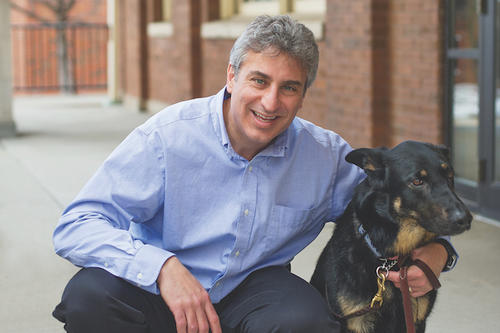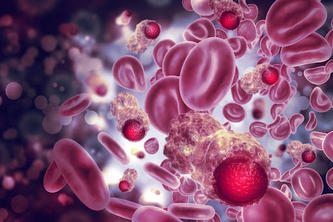
Hemangiosarcoma is a highly invasive type of cancer that grows rapidly. It primarily forms in dogs, but can also develop in humans and other animals.
Jaime Modiano with the University of Minnesota College of Veterinary Medicine and Masonic Cancer Center answers questions about what hemangiosarcoma is, the current standard of care, and the implications his cancer research has for veterinary and human medicine.
Q: What is hemangiosarcoma?
Dr. Modiano: Few canine cancers are deadlier than hemangiosarcoma, a cancer of blood vessel-forming cells. This cancer is unpredictable, develops painlessly and is often advanced by the time it is discovered. Severe internal bleeding and sudden death occur frequently and unexpectedly with this disease. A dog’s breed, age, gender, diet and environment do not impact the progression of this cancer.
Q: What is the survival rate for dogs with hemangiosarcoma?
Dr. Modiano: Hemangiosarcoma is most common in older dogs; more than half of the dogs that develop hemangiosarcoma are over 10 years old. Without treatment, the probability of survival can range from days to a few weeks. With treatment, the expected survival is four to six months, though this depends on the tumor’s location. Despite the aggressive nature of the disease, about five to 15 percent of dogs with hemangiosarcoma may survive a year or longer.
Q: What is the current standard of care for dogs with hemangiosarcoma?
Dr. Modiano: The standard of care is surgical removal of accessible tumors — depending on the location — followed by chemotherapy. Treatment is meant to prevent fatal blood loss and to extend life, but is seldom curative. Chemotherapy delays the recurrence of metastasis, which occurs in virtually every dog diagnosed with this cancer. The combination of surgery and chemotherapy is the only approach that has repeatedly shown to be effective. I strongly recommend owners pursue treatment options based on objective data and not on anecdotal information that creates false hope and unrealistic expectations by the pet owners and their veterinarians.
Q: How might research about hemangiosarcoma impact human medicine?
Dr. Modiano: There are many similarities between human and dog cancers — they arise spontaneously in both species, and, in some form, cancer will affect between 25 to 35 percent of both populations. Cancer is the major cause of disease-related mortality in dogs, as it is in humans in an increasing number of countries. Dogs can help us understand the lifelong impact of new strategies to diagnose, prevent and treat cancer because their lives are measured in the span of about a decade. As we develop tests for early detection that can be paired with new drugs for active, targeted prevention, success in dogs would provide an impetus for, and confidence in, further developing these approaches to assign cancer risk, and to use preventative strategies in humans.
Q: What are you and your team doing to reduce the impact of hemangiosarcoma?
Dr. Modiano: The Shine On Project at the University of Minnesota College of Veterinary Medicine is following over 200 healthy dogs at risk for developing hemangiosarcoma. The goal is to evaluate the use of a novel blood test to assign a level of risk to each of these dogs. Dogs that are at a high risk are eligible to receive eBAT — a promising drug developed at the University of Minnesota — as a preventative tool. eBAT is unique because it can kill the emerging cancer cells and irreparably damage the environment they need before they have a chance to form a tumor. An added advantage to eBAT is that it is exceptionally safe.
Our approach of detecting hemangiosarcoma early on through The Shine On Project and then combating it with eBAT is something our team now looks to apply to other types of cancer — most notably, osteosarcoma. Rather than curing dogs that already have cancer, we set ourselves apart by detecting it early and fighting it with specific, customized treatments, as we have done with the Shine On Project and our use of eBAT.
Jaime Modiano is the Alvin and June Perlman Professor of Oncology and Comparative Medicine in the University of Minnesota College of Veterinary Medicine and a Masonic Cancer Center member. His areas of expertise include cancer and immunology research.
About “Talking...with UMN”
“Talking...with UMN” is a resource whereby University of Minnesota faculty answer questions on current and other topics of general interest. Feel free to republish this content. If would like to schedule an interview with the faculty member or have topics you’d like the University of Minnesota to explore for future “Talking...with UMN,” please contact University Public Relations at [email protected].
- Categories:
- Health




